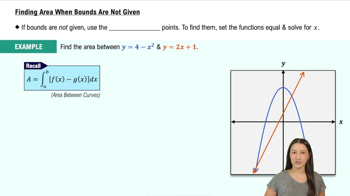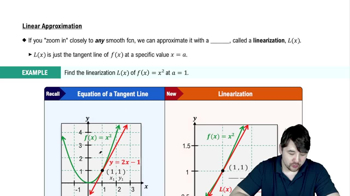The linear function ƒ(𝓍) = 3 ― 𝓍 is decreasing on the interval [0, 3]. Is its area function for ƒ (with left endpoint 0) increasing or decreasing on the interval [0, 3]? Draw a picture and explain.
Table of contents
- 0. Functions7h 54m
- Introduction to Functions16m
- Piecewise Functions10m
- Properties of Functions9m
- Common Functions1h 8m
- Transformations5m
- Combining Functions27m
- Exponent rules32m
- Exponential Functions28m
- Logarithmic Functions24m
- Properties of Logarithms36m
- Exponential & Logarithmic Equations35m
- Introduction to Trigonometric Functions38m
- Graphs of Trigonometric Functions44m
- Trigonometric Identities47m
- Inverse Trigonometric Functions48m
- 1. Limits and Continuity2h 2m
- 2. Intro to Derivatives1h 33m
- 3. Techniques of Differentiation3h 18m
- 4. Applications of Derivatives2h 38m
- 5. Graphical Applications of Derivatives6h 2m
- 6. Derivatives of Inverse, Exponential, & Logarithmic Functions2h 37m
- 7. Antiderivatives & Indefinite Integrals1h 26m
- 8. Definite Integrals4h 44m
- 9. Graphical Applications of Integrals2h 27m
- 10. Physics Applications of Integrals 3h 16m
- 11. Integrals of Inverse, Exponential, & Logarithmic Functions2h 34m
- 12. Techniques of Integration7h 41m
- 13. Intro to Differential Equations2h 55m
- 14. Sequences & Series5h 36m
- 15. Power Series2h 19m
- 16. Parametric Equations & Polar Coordinates7h 58m
8. Definite Integrals
Fundamental Theorem of Calculus
Problem 5.3.21b
Textbook Question
Area functions for linear functions Consider the following functions ƒ and real numbers a (see figure).
(b) Verify that A'(𝓍) = ƒ(𝓍).

ƒ(t) = 3t + 1 , a = 2
 Verified step by step guidance
Verified step by step guidance1
Step 1: Understand the problem. The goal is to verify that the derivative of the area function A(x) with respect to x is equal to the given function f(x). The area function A(x) represents the area under the curve y = f(t) from t = a to t = x.
Step 2: Recall the Fundamental Theorem of Calculus. It states that if A(x) is defined as the integral of f(t) from a to x, then the derivative of A(x) with respect to x is equal to f(x). Mathematically, this is expressed as:
Step 3: Define the area function A(x). Using the given function f(t) = 3t + 1 and the lower limit a = 2, the area function is:
Step 4: Differentiate A(x) with respect to x. By the Fundamental Theorem of Calculus, the derivative of the integral with respect to its upper limit x is simply the integrand evaluated at x. Therefore,
Step 5: Verify the result. The derivative of A(x) matches the given function f(x) = 3x + 1, confirming that A'(x) = f(x). This completes the verification.
 Verified video answer for a similar problem:
Verified video answer for a similar problem:This video solution was recommended by our tutors as helpful for the problem above
Video duration:
3mPlay a video:
Was this helpful?
Key Concepts
Here are the essential concepts you must grasp in order to answer the question correctly.
Area Function
An area function, denoted as A(x), represents the accumulated area under a curve from a fixed point 'a' to a variable point 'x'. In this context, it quantifies the area between the x-axis and the function f(t) = 3t + 1 over the interval [a, x]. Understanding this concept is crucial for analyzing how the area changes as 'x' varies.
Recommended video:

Finding Area When Bounds Are Not Given
Fundamental Theorem of Calculus
The Fundamental Theorem of Calculus links differentiation and integration, stating that if A(x) is the area function defined as the integral of f(t) from a to x, then the derivative A'(x) equals f(x). This theorem is essential for verifying the relationship between the area function and the original function, as required in the question.
Recommended video:

Fundamental Theorem of Calculus Part 1
Linear Functions
A linear function is a polynomial function of degree one, typically expressed in the form f(t) = mt + b, where m is the slope and b is the y-intercept. In this case, f(t) = 3t + 1 is a linear function with a slope of 3, indicating a constant rate of change. Understanding linear functions is vital for interpreting the graph and calculating the area under the curve.
Recommended video:

Linearization

 6:11m
6:11mWatch next
Master Fundamental Theorem of Calculus Part 1 with a bite sized video explanation from Patrick
Start learningRelated Videos
Related Practice
Textbook Question
23
views
